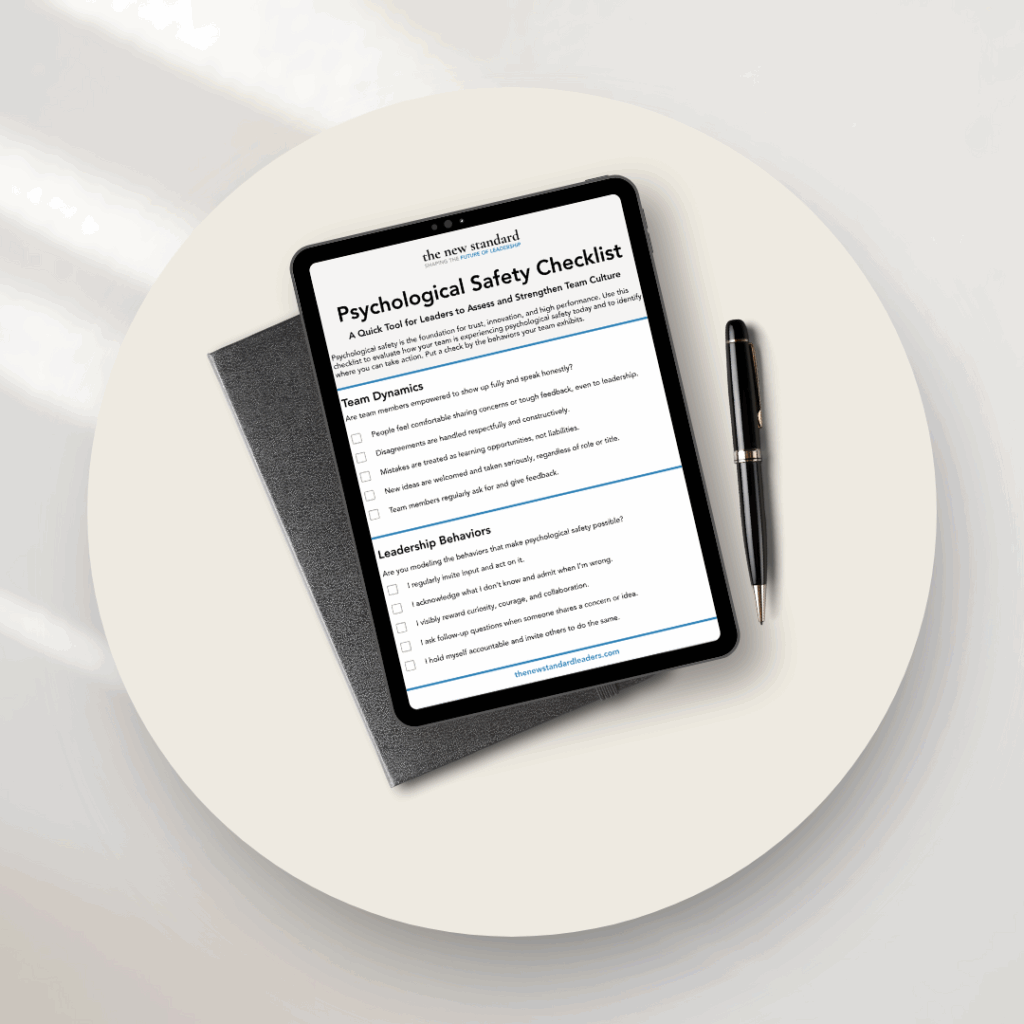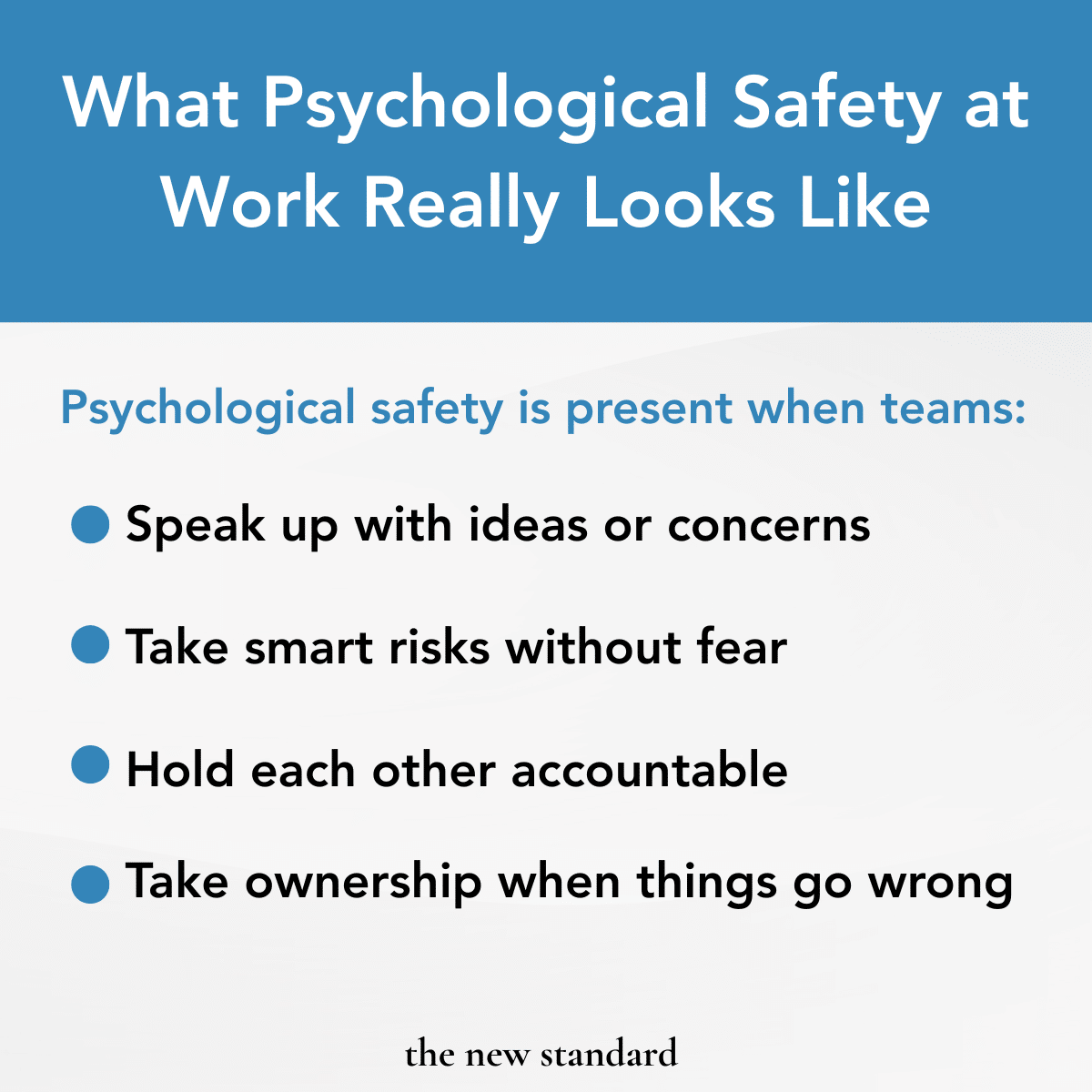One of our clients came to us with a familiar challenge: their team was talented, motivated, and full of ideas, but in meetings, only a few voices spoke up. The rest stayed quiet.
Their silence wasn’t because they didn’t have something to say, but because they didn’t feel safe enough to say it.
The leader found this silence frustrating because he knew it stifled innovation, slowed progress, and created missed opportunities.
What was missing? Psychological safety, the belief that you can raise concerns, share ideas, or admit mistakes without fear of being dismissed or penalized. Harvard’s Amy Edmondson gave it a name, and forward-thinking leaders are the ones putting it into action.
It’s important to note that psychological safety isn’t built through policies or posters. It’s built, day by day, through how leaders show up and how culture is shaped.
At The New Standard, we’ve seen this play out again and again. When leaders prioritize psychological safety, teams communicate with clarity, take smarter risks, and operate with greater trust. When they don’t? Silence becomes the norm. And with it, momentum stalls.
So, how do you build psychological safety where it counts, right now, in your organization?
Let’s break it down.
What Psychological Safety at Work Looks Like in Practice
Psychological safety doesn’t always make the leadership agenda, but it should. It’s one of the most powerful, often overlooked drivers of performance and growth. It shows up in how teams operate, how they solve problems, and how they perform under pressure.
One of the clearest examples of this comes from Google. When Google set out to understand what made its highest-performing teams succeed, they launched Project Aristotle, a deep-dive research initiative analyzing over 180 teams. The most surprising finding?
It wasn’t technical expertise, leadership style, or team structure that predicted success.
It was psychological safety.
Teams with high psychological safety consistently outperformed others. Why? Because team members felt safe taking risks, asking questions, and admitting mistakes without fear of embarrassment or punishment.
This sense of safety fostered trust, deeper collaboration, and faster problem-solving. It didn’t just improve morale, it improved results.
When psychological safety is present, you feel it. The energy shifts. People:
- Speak up freely with new ideas or concerns
- Take smart risks without fear of punishment
- Collaborate openly and hold each other accountable
- Bounce back faster from setbacks
These aren’t abstract concepts. They’re the building blocks of high-performance teams.
But when psychological safety is missing? The signs are just as clear and far more costly. You’ll see:
- People staying quiet in meetings
- A culture of blame and finger-pointing
- Stalled innovation and low engagement
- High turnover and lost talent
Leadership Behaviors That Build Workplace Psychological Safety
Psychological safety doesn’t come from a memo or an all-hands presentation. It comes from how leaders show up every day in the moments that matter.
You can’t delegate this. You can’t shortcut it. If you want your team to speak up, take initiative, and stay engaged, it starts with what you model.
Here’s what that looks like in action:
1. Lead with Humility
Admit what you don’t know. Invite questions. Show that it’s okay not to have all the answers.
2. Encourage Risk-Taking Without Fear
Make it clear mistakes aren’t punishable but are opportunities to learn and improve.
3. Listen Actively
Pay attention to what your people are saying and where they are holding back. Ask follow-up questions. Validate their experiences.
4. Model Accountability
Own your own missteps openly. When leaders hold themselves accountable, it sets the tone for the whole team.

Psychological Safety Checklist
Want a simple way to assess where your team stands?
Download our free Psychological Safety Checklist, a quick, practical tool to help you identify strengths, spot red flags, and start building a safer, higher-performing team.
Psychological Safety Checklist
Creating Conditions for Building Trust at Work
Even the most self-aware leader can only go so far if the broader environment works against them. Psychological safety may start with leadership behavior, but it’s sustained, or sabotaged, by the systems, structures, and norms that surround your teams.
If your culture sends mixed signals like encouraging honesty in theory but punishing it in practice, people notice, and they adapt accordingly.
To build a foundation of safety that lasts, organizations need to back up leadership intentions with cultural alignment and operational support. That includes:
- Clear norms that promote respect and inclusion
Define and reinforce expectations around communication, decision-making, and collaboration. People should know what it means to engage constructively—and what’s out of bounds. - Structures that encourage feedback loops and transparency
Create formal and informal channels where employees can share feedback safely and know it will be taken seriously. - Recognition systems that reward collaboration and courage
Don’t just celebrate outcomes, recognize behaviors. Spotlight those who ask tough questions, speak truth to power, and challenge assumptions in service of the team. - Training and coaching that reinforce safe behaviors
Support leaders and employees in developing the emotional intelligence, communication skills, and habits that make psychological safety a lived experience and not just one that’s talked about.
Culture is more than words on a wall. It’s the daily reinforcement (or erosion) of values in action. If you want psychological safety to stick, build it into the bones of your organization.
Measuring Psychological Safety in the Workplace
You can’t change what you haven’t acknowledged, and you can’t improve what you aren’t measuring.
Psychological safety may feel intangible, but there are concrete ways to assess it. Pulse surveys, listening sessions, and one-on-one conversations can surface critical insight into how safe or unsafe your people feel on the job.
The goal isn’t to get a perfect score. It’s to get an honest picture. Start with questions like:
- Do you feel safe sharing your honest opinions at work?
- Have you ever held back an idea because you were afraid of the reaction?
- How comfortable are you admitting mistakes or asking for help here?
- Do you feel like your input is valued or ignored?
These answers won’t just tell you where psychological safety stands. They’ll point you toward what needs attention next, and the very act of asking sends a powerful message: “We’re listening.”
Research backs this up.
Harvard professor Amy Edmondson, who coined the term psychological safety, first discovered its importance while studying hospital teams.
She expected the highest-performing teams to report fewer errors. But to her surprise, they reported more.
At first glance, it looked like these teams were making more mistakes. But they weren’t. They were simply more willing to speak up about them because they felt safe to do so.
Teams with low psychological safety weren’t safer. They were silent.
The takeaway?
Psychological safety doesn’t increase mistakes. Instead, it increases visibility, and that visibility fuels faster learning, stronger collaboration, and better results.
Why Psychological Safety at Work Matters Now More Than Ever
Disruption is the norm. Priorities shift fast. The companies that thrive aren’t the ones with the flashiest strategy, they’re the ones with teams who can think clearly, adapt quickly, and challenge the status quo without fear.
That only happens in environments where psychological safety is present.
In a world where innovation is the essence of staying competitive, silence is a risk no leader can afford. Teams need to speak up, share bold ideas, and flag what’s not working before small issues turn into major problems.
The best leaders know psychological safety drives both culture and results, and they treat it like it matters.
Want to learn more about how to make psychological safety the foundation of your leadership strategy?
Download our free Psychological Safety Checklist, a simple tool to assess and start building safety in your teams today.


